Why Assassin's Creed Odyssey is best played on PS4 Pro and Xbox One X
Smoother, cleaner, faster.
Assassin's Creed returns once again with the excellent Odyssey, built upon the same technological revamp that successfully powered last year's Origins. By and large, it's a successful multi-platform deployment across consoles and PC, but similar to the last offering, it's best played on the enhanced '4K' consoles. There's an almost majestic scale and scope to this new title across all systems, but it's PS4 Pro and Xbox One X that deliver a quantifiably smoother, more consistent experience over base consoles.
Technologically, Odyssey follows Origins in adjusting rendering resolution according to load, improving image quality using a variant of the temporal anti-aliasing technology pioneered in the remarkable For Honor. So yes, if we look at the raw numbers, there is a clear resolution boost as we scale the console power ladder - base Xbox console at the bottom, followed by a 1080p-centric PS4, before we move on to Pro and Xbox One X at the top end of the scale. However, the traditional way we perceive resolution - edge jaggies, pixel-popping, etc - is circumvented via the use of TAA.
The end result is that more GPU power simply translates into more clarity. It's an elegant solution that gives the developers the freedom to more easily deliver their vision without being limited by the host platform. If the scene is more complex, resolution drops, but the end result still looks fairly consistent, and even platform comparisons hold up fairly well in motion. Think of each system as having a specific resolution window designed - in theory - to keep the game running smoothly at 30fps and this effectively sums up how both Origins and Odyssey work. However, the implementation varies fairly dramatically.
With Xbox One X, resolution scales in a window broadly between 2944x1656 all the way up to full 4K - 3840x2160. That's a fairly wide range of potential values then - around 60 per cent of native 4K resolution up to 100 per cent. That range is much more constricted on PS4 Pro - values of 2227x1242 at the lower end to 2816x1584 at the top deliver 33 per cent to 54 per cent of a native 4K framebuffer. But the point is that the delta between lowest and highest measurements on both systems is in the 60 to 70 per cent range - that's a wide range of real estate Ubisoft can work with in maintaining performance.
Take a look at the screenshot comparisons on this page and despite what looks like a yawning chasm in pixel-count between Pro and X, the Sony platform holds up fairly well - it's only at the lowest points where the differences are pronounced. We saw exactly the same thing with Origins last year - X presents extra clarity and refinement, but not a game-changer experience in line with the numbers.
As you would expect, moving over to the base consoles drops resolution significantly - but so does the range of the window allowed to the dynamic scaler. The base Xbox One suffers most, with a 1344x756 lower bounds and a 1600x900 top-end. The same 900p is the lowest measurable point on PlayStation 4, rising to a maximum of 1080p. However, the key point here is that window open to the DRS scaler on both systems is narrower than the enhanced counterparts - in the 40 per cent range on both systems.




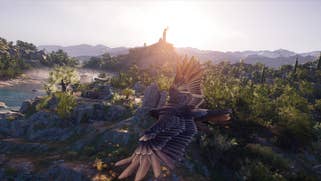
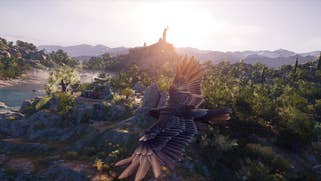
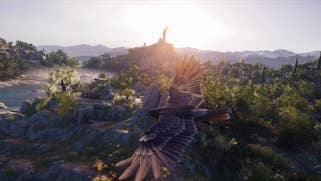
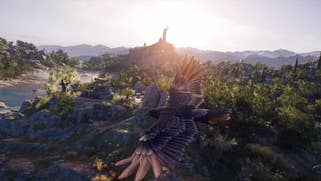











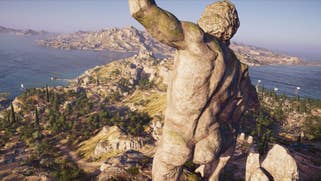




The presentation loses its sheen towards the lower end in heavier scenes, especially on Xbox One, where there's simply not enough resolution to stop the game looking somewhat murky. Additionally,the narrower window for the scaler also means that the heaviest scenes drop more frames than they on the enhanced consoles - effectively, the game isn't only blurrier, it's also less stable in motion.
It's borne out in the performance metrics, where the most GPU-heavy scenes see performance twitch momentarily under 30fps on both PS4 Pro and Xbox One X, but with significantly higher hits to performance on the base machines. Of the two, it's Xbox One that's struggles through most with its 20-30fps range. On the one hand, most horseback riding, eagle-flying or general talk with NPCs tick along with few issues at 30fps. It's just the peak stress areas that pose a problem: the ship battles, the cut-scenes, and especially the intro fight where the screen is packed with spartans. Even dropping to a native 756p in these moments, the Microsoft machine is also finding itself in the mid, or even low 20s - which isn't good enough. By comparison, PS4 is a step up, but not by a massive degree. The same problems flag in all of the same areas and while there's a similar 20-30fps window, PlayStation does run faster overall. It's worth stressing again that there is a bulk of gameplay that runs at 30fps, but when push comes to shove, performance noticeably drops in areas where the enhanced consoles run fine.
Another concern is the asset streaming. This applies to base PS4 and Xbox One, on very select occasions - but it's an issue that doesn't manifest on the enhanced machines at all. You can be travelling on horseback at a fair pace, only for the engine to suddenly freeze-frame, displaying a loading icon. It's most likely a streaming issue hinging on HDD speeds, or even the rate of decompressing background data on the CPU - in play, it's almost as if you can traverse the environment faster than the game can keep up. Hopefully the developer can take a look at this and resolve the issue in a title update. In our experience, the issue occurs more frequently on Xbox than it does on PlayStation, and to reiterate, we've yet to experience it at all on either of the enhanced machines.
Beyond that, differences between the four consoles extend to more minor tweaks in the visual feature set. Shadow draw distance is reined in on the base machines, while Xbox One X sees a small improvement over Pro. Ambient occlusion varies between the four, but it's by a subtle degree that won't affect your play-through. Shade is most obviously improved on X, though you're not being short-changed by the way the game appears up-close on base machines. Texture detail occasionally sees a small X advantage over Pro, but examples we found were likely streaming anomalies - for the most part, the assets are a match.
Xbox One X has a memory advantage over Pro and the way this manifests in-game is intriguing. Assassin's Creed Odyssey retains the eagle mechanic that debuted in Origins, meaning that when you shift viewpoint and scout ahead with Ikaros, the streaming systems adjust to his viewpoint. Move too far ahead and returning to Kassandra/Alexios causes a fade to black and a pause as the assassin's environment data is reloaded. The shift back on Xbox One X is much more seamless - in effect, the extra memory is used to accommodate location data for both eagle and assassin: it's a small improvement, but notable nonetheless.
But the real dividing line here is between the base and enhanced consoles in how they look and play. Consistency in terms of image quality and performance is much improved on PS4 Pro and Xbox One X - our only slight disappointment here being that there are still some minor dips below the 30fps target. X offers additional clarity and minor visual refinements, but the game looks and runs well on both of the mid-gen refresh consoles. Beyond that, PS4 is a step down but it does hold up - if you're braced for the performance dips and odd streaming troubles, image quality generally looks fine on a 1080p screen. Xbox One is a further down the ladder - significantly so - and perhaps a quality threshold is crossed: the picture is visibly blurrier from the harsher resolution scaling, and frame-rate is more unstable too. In the final analysis, it's a no-brainer then - PS4 Pro and Xbox One X quantifiably offer the best way to play, with Microsoft's enhanced console delivering the most refined experience overall.











